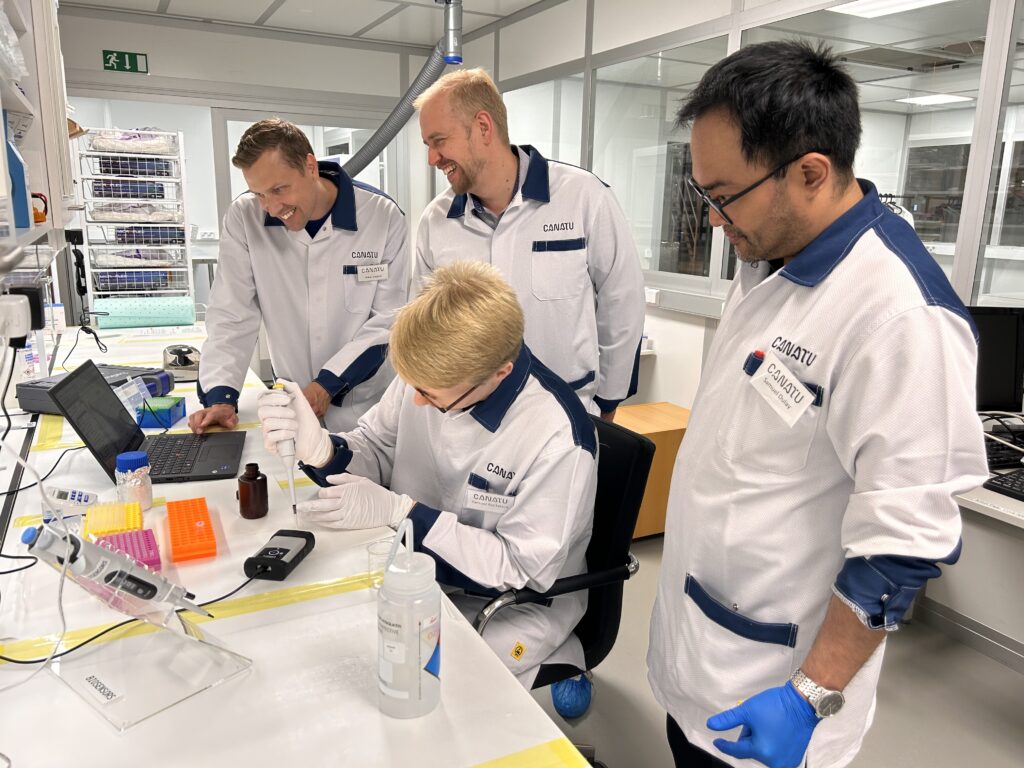Latest research on electrochemical biosensors using Canatu CNT
At Canatu, our unique expertise is how we adapt carbon nanotubes (CNTs) to different contexts and uses. In partnership with forerunners, we innovate breakthroughs with the potential to redefine industries. Seeking new opportunities comes naturally to us, and our experts are continuously thinking ahead of what’s to come, expanding what is possible with nanocarbon.
Currently, our technology for electrochemical sensors is developing fast. Because of the exceptional purity of Canatu carbon nanotubes, remarkable analytical performance can be attained in various sectors such as clinical analysis, environmental monitoring, agriculture and neuroscience. Our CNT material is manufactured using a proven mass production process.

Versatile platform technology
The properties of Canatu CNT films have many advantages, including high electrical conductivity and low detection limit. Due to our proprietary dry deposition technology, the CNT electrode fabrication process does not rely on ultrasonication or the use of dispersion agents that would detrimentally affect sensor performance. Instead of that, our process generates highly clean CNT surfaces with controllable reactive surface area, providing means for obtaining strong electrochemical signal and unparalleled sensitivity. We also have extensive experience in post processing of CNTs, including surface functionalization to improve sensitivity and selectivity, whereas we also have experience in strongly immobilizing biorecognition elements such as antibodies and aptamers directly to the electrode surface.
Electrochemical sensors using Canatu CNT can provide a rapid, precise, and low-cost method for quantitative analysis across various industries. Canatu stands out by offering the most advanced carbon nanotubes and wealth of expertise in customizing the material to match specific application needs. This is complemented by our extensive track record of over a decade in successfully mass producing CNTs for highly engineered solutions.
A concrete proof of our capabilities in electrochemical sensing is a growing list of academic publications.
Here is a summary of our recent research with the ecosystem partners and academia.
Introduction of an electrochemical point-of-care assay for quantitative determination of paracetamol in finger-prick capillary whole blood samples
Kujala, J.; Wester, N.; Lohela, T. J.; Kurkela, M.; Backman, J.T.; Mikladal B.; Laurila, T.; Koskinen, J.; Lilus, T. O.; Kalso, E. A., British Journal of Clinical Pharmacology, 89(9), 2933-2938 (2023)
The paracetamol capillary blood concentrations measured with the novel electrochemical ‘point-of-care’ method correlate with the ‘gold standard’ HPLC-MS/MS method in capillary blood.
Rapid industrial scale synthesis of robust carbon nanotube network electrodes for electroanalysis
Leppänen, E et al. Journal of Electroanalytical Chemistry, vol. 896 (2021)
Canatu electrochemical sensors can be produced at industrial scale and reproducibility. We also have the possibility to modify CNT deposition process parameters to alter the electrochemical response, as was demonstrated in this article. These results provide a proof-of-principle that both the sensitivity and selectivity towards analytes-of-interest can be modified by altering the morphology of the SWCNT network.
Real-time selective detection of dopamine and serotonin at nanomolar concentration from complex in vitro systems
Rantataro, S et al. Biosensors and Bioelectronics 115579 (2023)
Canatu SWCNT electrodes show outstanding analytical performance, being capable of simultaneously detecting dopamine and serotonin at nanomolar concentration in the highly fouling culture medium. Analytical performance of our SWCNT electrodes in culture medium is comparable to the performance of other state-of-the-art electrodes in highly clean phosphate buffer, which lacks all the fouling components present in culture medium. Perhaps most importantly, this state-of-the-art analytical performance can now be finally obtained at industrial scale and reproducibility.
The Canatu SWCNT electrodes also demonstrate excellent biocompatibility, as they were able to sustain healthy development of primary midbrain dopaminergic neuron culture. Because of the unique combination of excellent analytical performance and biocompatibility, Canatu SWCNTs are currently the only material capable of being integrated into brain-on-a-chip devices. Furthermore, they could be used for the monitoring of complex in vitro models to facilitate drug discovery and development.
Ascorbic acid does not necessarily interfere with the electrochemical detection of dopamine
Rantataro, S. et al. Sci Rep 12, 20225 (2022)
Electrochemical detection of neurotransmitters is severely complicated by the presence of ascorbic acid. However, this challenge can be eliminated through experimental design in vitro. By utilizing the highly sensitive Canatu SWCNTs, nanomolar detection of dopamine was demonstrated for the first time, as measured directly from the cell culture medium in the presence of ascorbic acid at initially high concentration.
Electrochemical Detection of Oxycodone and Its Main Metabolites with Nafion-Coated Single-Walled Carbon Nanotube Electrodes
Mynttinen, E et al. Analytical Chemistry 92 (12), 8218-8227 (2022)
We developed a disposable, mass-producible Nafion-coated single-walled carbon nanotube sensor and demonstrated, for the first time, selective detection of oxycodone in the presence of its two major metabolites.
Disposable Nafion-Coated Single-Walled Carbon Nanotube Test Strip for Electrochemical Quantitative Determination of Acetaminophen in a Finger-Prick Whole Blood Sample
Wester, N et al. Analytical Chemistry 92 (19), 13017-13024 (2020)
Our mass-production compatible fabrication process has also been used to develop a quantitative point-of-care sensor for the determination of acetaminophen within the clinically relevant concentration range.
Electrochemical Detection of Morphine in Untreated Human Capillary Whole Blood
Verrinder, E et al. ACS Omega 6 (17), 11563-11569 (2021)
In this work, we demonstrated quantitative electrochemical detection of clinically relevant concentrations of morphine in undiluted and untreated capillary whole blood.
Effect of Electrochemical Oxidation on Physicochemical Properties of Fe-Containing Single-Walled Carbon Nanotubes
Verrinder, E et al. ChemElectroChem 6 (17), 11563-11569 (2021)
In this article, we studied how the Fe-nanoparticle oxidation state affects analytical performance of our SWCNT electrodes. Whereas sensitivity towards the detection of analgesics was only marginally affected by the oxidation state, selectivity between paracetamol and morphine could be improved by electrochemical pre-treatment.
On the lookout for new partners
Our team works on developing carbon nanotubes and exploring new territory to find the types of applications we could help create. We are looking for partners to take things further forward.
Contact



